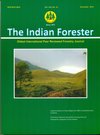Diversity of Ganoderma lucidum Collected from Different Host Tree Species from North India
DOI:
https://doi.org/10.36808/if/2016/v142i12/61746Keywords:
Ganoderma lucidum Collection, Host Tree Species, Medicinal Mushroom, Morphology, Sporophores, S.S.I.Abstract
Ganoderma lucidum is an important medicinal mushroom being used in clinical, pharmaceutical and nutritional industry for the treatment of various diseases such as migraine, hypertension, asthma, hepatitis and cardiovascular problems. Originally, G. lucidum (Traditional Chinese Medicine) was used in China, a very important component of the Chinese treasure of culture. It is distributed over a broad ecogeographical range and has been reported on more than 144 host tree species and in India it grows nearly on 62 different host tree species. Natural conditions based on local environmental variations can promote phenotypic differentiation among different isolates. Present study reports collection of sporophores from 15 different host tree species from north India, showed diversity in their morphological characters.References
Bhosle S., Ranadive K., Bapat G., Garad S., Deshpande G. and Vaidya J. (2010). Taxonomy and Diversity of Ganoderma from the Western parts of Maharashtra (India). Mycosphere, 1: 249–262.
Fernando K.M.E.P. (2008). The host preference of a Ganoderma lucidum strain for three tree species of Fabaceae family; Cassia nodosa, Cassia fistulaand Delonix regia. J. the National Science Foundation of Sri Lanka, 36: 323-326.
Gottlieb A.M. and Wright J.E. (1999). Taxonomy of Ganoderma from southern South America: subgenus Ganoderma. Mycological Research, 103: 661-673.
Harsh N.S.K., Rai B.K. and Tiwari D.P. (1993). Use of Ganoderma lucidum in folk medicine. I. Tropical Biodiversity, 1: 324-326.
Kumari S. and Harsh N.S.K. (2004). Host range of Ganoderma lucidum in India. Indian J. Forestry, 27: 213-215.
Ji-Ding Zhao. (1989). The Ganodermataceae in China, Biblioheca Mycologica Band 132, J. Cramer, Berlin, Stuttgart, 1989.
Mohanty P.S., Harsh N.S.K. and Pandey A. (2011). First report of Ganoderma resinaceum and G. weberianum from north India based on ITS sequence analysis and micromorphology. Mycosphere, 2: 469-474.
Ryvarden L. (1994). Can we trust morphology in Ganodrma. In Ganoderma systematics, phytopathology and pharmacology. (Buchannan, P. K., Hseu, R. S. and Moncalvo, J. M. eds) Proceedings of contributed symposia 59AB: Fifth International Mycological congress, Vancouver.1995; August 14-21, pp 135-165.
Ryvarden L. and Johansen I. (1980). A preliminary polypore flora of East Africa. Oslo Fungiflora.
Singh S., Harsh N.S.K. and Chandra S. (2014). Morphological studies of Ganoderma lucidum from different host tree species. Inte. J. Institutional Pharmacy and Life Sciences, 4(4):40-49.
Wagner R., Mitchell D.A., Sassaki G.L. and Amazonas MALA. (2004). Link between morphology and physiology of Ganoderma lucidum in submerged culture for the production of exopolysaccharide. J. Biotechnol., 114: 153-164.
Downloads
Downloads
Published
How to Cite
Issue
Section
License
Unless otherwise stated, copyright or similar rights in all materials presented on the site, including graphical images, are owned by Indian Forester.





